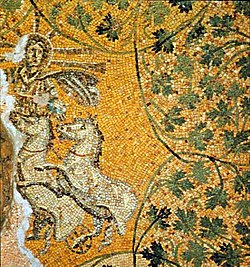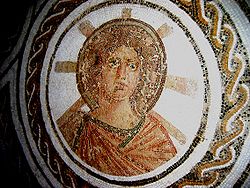Helios


Helios (altgriechisch ἭλιοςHḗlios „Sonne“, bei Homer ἨέλιοςĒélios) ist in der griechischen Mythologie der Sonnengott. Zusammen mit Selene (Mondgöttin) und Eos (Göttin der Morgenröte) ist er ein Kind der Titanen Hyperion und Theia.[1]
Aufgaben
Die Aufgabe des Helios war es, den Sonnenwagen über den Himmel zu lenken, der von vier Hengsten gezogen wurde. Dabei ging Eos vor ihm, Selene folgte am Abend. Helios gilt als Gott, der alles sieht und hört,[2] weshalb er einer der Götter ist, welche die Einhaltung von Schwüren bzw. Eiden garantieren.[3]
Gleichsetzungen
In der griechischen Klassik wurde Helios mit Apollon gleichgesetzt, mit dem er den Namen Phoibos („der Leuchtende“) teilt. Ihm entsprach Sol in der römischen Mythologie.
Fallweise wurde er außerdem in der späteren römischen Zeit mit diversen anderen Gottheiten verschmolzen (Synkretismus), so beispielsweise mit Mithras.[4]
Mythen
Helios offenbart dem Hephaistos den Seitensprung seiner Gattin Aphrodite mit Ares.[5]
Weil die Gefährten des Odysseus verbotenermaßen die Rinder des Helios geschlachtet hatten, vernichtet Zeus sie auf Bitten des Sonnengottes.[6]
Nachkommen
Helios hatte mit Klymene vier Kinder: Aigle, Phaethusa, Lampetia (die drei Heliaden) und Phaethon.[7] Mit Perse zeugte er Kirke, Pasiphaë, Aietes und Perses.[8]
Der Koloss von Rhodos war ein Standbild des Helios mit Strahlenkrone.
Stammbaum
Stammbaum der Titanen
| Chaos | → | Gaia | → | Uranos | |||||||||||||||||||||||||||||||||||||||||||||||||
| Göttergeschlecht | der Titanen | ||||||||||||||||||||||||||||||||||||||||||||||||||||
| Okeanos | Kreios | Hyperion | Theia | Themis | Phoibe | ||||||||||||||||||||||||||||||||||||||||||||||||
| Kronos | Koios | Iapetos | Rhea | Mnemosyne | Tethys | ||||||||||||||||||||||||||||||||||||||||||||||||
| Eos | Helios | Selene | |||||||||||||||||||||||||||||||||||||||||||||||||||
Stammbaum des Helios
| Hyperion | Theia | ||||||||||||||||||||||||||||||||||||
| Selene | Eos | Helios | Klymene | ||||||||||||||||||||||||||||||||||
| Perse | |||||||||||||||||||||||||||||||||||||
| Aigle | Phaetusa | Lampetia | Phaethon | ||||||||||||||||||||||||||||||||||
| Kirke | Pasiphae | Aietes | Perses | ||||||||||||||||||||||||||||||||||
Bilder
- Apollon-Sol mit siebenstrahliger Sonnenkrone des Helios, römisches Bodenmosaik, Tunesien, spätes 2. Jahrhundert.
- Helios im Sonnenwagen, begleitet von Phosphorus (Fackel), Hermes (Flügelhelm) und anderen; Fresko von J. B. Zimmermann, Schloss Nymphenburg, München, 17. Jahrhundert.
- Helios-Statuette, Archäologisches Museum in Antalya
- Deckenmosaik, Detail, Christus-Helios mit siebenstrahliger Sonnenkrone im Sonnenwagen; Mausoleum M (Julier), Vatikanische Nekropole, St.-Peter-Basilika, Rom, 3. Jahrhundert.[9]
- Giebelfeld mit Helios-Relief, Helios im vierspännigen Sonnenwagen mit Phosphorus und den drei Horen, Stuttgart, Schloss Rosenstein
Literatur
- Adolf Rapp: Helios. In: Wilhelm Heinrich Roscher (Hrsg.): Ausführliches Lexikon der griechischen und römischen Mythologie. Band 1,2, Leipzig 1890, Sp. 1993–2026 (Digitalisat).
- Petra Matern: Helios und Sol. Kulte und Ikonographie des griechischen und römischen Sonnengottes. Ege Yayınları, Istanbul 2002, ISBN 975-8070-53-3.
Weblinks
Anmerkungen
- ↑ Hesiod, Theogonie 371–374; Bibliotheke des Apollodor 1,2,2
- ↑ Homer, Ilias 3,277; Homer, Odyssee 11,109; 12,323.
- ↑ Homer, Ilias 3,276-280; 19,258-260.
- ↑ Wolfgang Fauth: Helios Megistos. Zur synkretistischen Theologie der Spätantike (= Religions in the Graeco-Roman World. Band 125). Brill, Leiden u. a. 1995, ISBN 90-04-10194-2.
- ↑ Homer, Odyssee 8,266–366.
- ↑ Homer, Odyssee 12,260–425.
- ↑ Hyginus, Fabulae 156.
- ↑ Hyginus, Fabulae, Praefatio.
- ↑ Mosaiktitel: „Christus als Sol Invictus“, interpretiert als Christus-Sol. Die frühen Heidenchristen kombinieren hier urchristlichen und heidnischen Glauben in diesem Mosaik von Jesus Christus als Sonnengott. Der triumphierende Gott Christus wird von zwei Pferden in seinem Sonnenwagen gezogen. Die Weinranken des Dionysus, der nach griechisch-römischer Mythologie aus der Unterwelt wiederkam/auferstand, werden zu Weinranken Jesu.
Auf dieser Seite verwendete Medien
*Ceiling Mosaic - Christus helios, the mosaic of Sol in Mausoleum M, which is interpreted as Christ-Sol (Christ as the Sun).
Detail of vault mosaic in the Mausoleum of the Julii. From the necropolis under St. Peter's Mid-3rd century, Rome.
Mosaic from the Vatican Necropolis under St. Peter's Basilica, on the ceiling of the Tomb of the Julii. Representation of Christ as the sun-god Helios or Sol Invictus riding in his chariot. Dated to the 3rd century AD.
"Early Christian and pagan beliefs are combined in this third century mosaic of Christ as a sun-god. The triumphant Christ/god, with rays shooting from his head, is pulled aloft by two rearing horses in his chariot. The Dionysian vines in the background become the vines of Christ."
- Title: Christ as Sol Invictus
- Late 3rd century
"The First Apology" by St. Justin Martyr, an early Christian, quotes Psalm 19:5-6, a verse that was very popular with early Christians. It was associated with the ancient Christian custom of praying toward the East, the direction of Christ's Ascension and second coming, instead of toward Jerusalem as Jews did:
"And hear how it was foretold concerning those who published His doctrine and proclaimed His appearance, the above-mentioned prophet and king [David] speaking thus by the Spirit of prophecy. "....In the sun has He set His tabernacle, and he as a bridegroom going out of his chamber shall rejoice as a giant to run his course."
Christ was also associated with "the Sun of justice with its healing rays", a Messianic image from Malachi 3:20.
From "THE BONES OF ST. PETER : The First Full Account of the Search for the Apostle's Body (Doubleday, 1982) by John Evangelist Walsh"; plate 7 shows a larger black-and-white image; p.26 says that three other mosaics in the tomb on the walls show (a) Jonah falling from a ship and being swallowed by the whale, (b) a fisherman standing on rocks fishing (c) the good shepherd with a sheep across his shoulders. The mosaic on the dome comes half-way down the walls. The rays of light "strongly suggest the form of a cross." The tomb was decorated about 250 with these motifs. The damage to the mosaic on the left is in fact a hole in the centre of the ceiling. The tomb was accessed from the street of pagan Roman tombs, and the access covered by a slab. When this was lifted, the hole in the middle of the dome was accessible. The tomb is described, not as a papal tomb, but as the "tomb of the golden mosaic." Originally it contained a pagan burial of a child and no adornment. Around 250 the family had converted to Christianity, and redecorated it. Three Christian burials were located under the floor. A story from 1574 relates how workmen had opened "a tomb with golden mosaics and two white horses", and found a body on a slab on the floor covered with quicklime; the body was not present when the tomb was located again during the 1941 excavations.Autor/Urheber: Mathiasrex, Lizenz: CC BY 2.5
Apollo
author-Maciej Szczepańczyk-user:Mathiasrex Apollo on the Roman mosaic El-Jem, TunisiaAutor/Urheber: Wolfgang Sauber, Lizenz: CC BY-SA 3.0
Archäologisches Museum in Antalya. Statuette des Gottes Helios.
© Hubertl / Wikimedia Commons, CC BY-SA 4.0
Sonnengott Helios, Kuppelfigur am Naturhistorischen Museum, Wien Österreich
Ludwig Mack: Helios-Relief (1830), mittlerer Teil.
Autor/Urheber: ArchaiOptix, Lizenz: CC BY-SA 4.0
- object type: wall painting (fresco)
- description: beardless Dionysos with long torch sitting on a throne, with Helios and Aphrodite and other gods - period / date: fourth style of pompeian wall painting - height: 100 cm - width: 93 cm - findspot: Pompeii VII, 2, 16, house of M. Gavius Rufus, exhedra (o) - museum / inventory number: Napoli, Museo Archeologico Nazionale 9449
- Please note: The above museum permits photography of its exhibits for private, educational, scientific, non-commercial purposes. If you intend to use the photo for any commercial aim, please contact the museum and ask for permission.



![Deckenmosaik, Detail, Christus-Helios mit siebenstrahliger Sonnenkrone im Sonnenwagen; Mausoleum M (Julier), Vatikanische Nekropole, St.-Peter-Basilika, Rom, 3. Jahrhundert.[9]](http://upload.wikimedia.org/wikipedia/commons/thumb/6/6c/ChristAsSol.jpg/120px-ChristAsSol.jpg)








